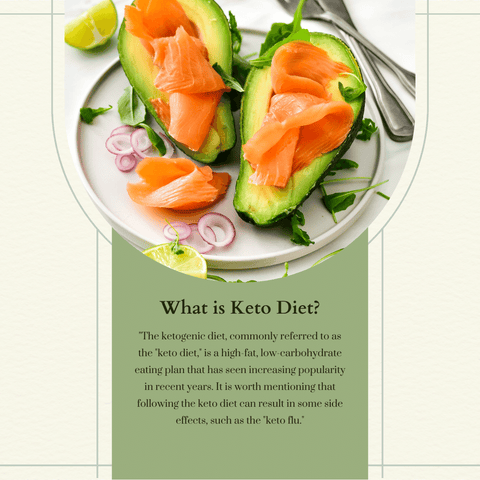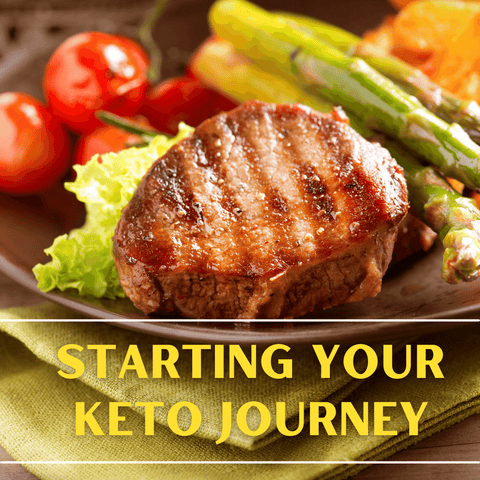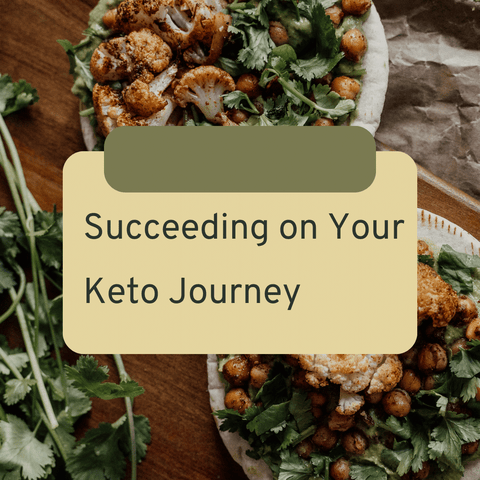For many people, starting a ketogenic diet can be a life-changing experience, but it necessitates meticulous macronutrient tracking and a laser-like focus on low-carb, high-fat foods. This blog will support you during your ketogenic journey; included below are some of the top applications for tracking your macronutrients, organising your meals, and staying on track.
Unlocking the Potential of the Ketogenic Lifestyle

The ketogenic lifestyle, also referred to as the keto diet, is a low-carb, high-fat dietary strategy that has grown in popularity due to its ability to aid in weight loss, enhance metabolic health, and offer a number of other health advantages. It's important to approach it consciously, be flexible, and put your long-term health and wellbeing first. Consult a trained dietician or healthcare professional for individualised advice if you have particular health goals or concerns.
1. Embracing the Ketogenic Diet: A Low-Carb Adventure
Adopting the ketogenic diet can be a thrilling low-carb adventure with a number of possible health advantages. Here is a closer look at how to start this journey, including research and education, setting specific goals, planning and preparation, monitoring macronutrients, low-carb vegetables, healthy fats, protein sources, hydration, and electrolytes, gradual transition, individual variation, lifestyle and exercise, professional consultation, and routine assessments. It's crucial to embark on this low-carb journey consciously, pay attention to nutritional quality, and be flexible if necessary. Prioritise your long-term health and wellbeing when making any dietary changes.
2. Keto Diet Apps: Your Pocket-Sized Ketosis Coach
You can assist your low-carb, high-fat journey with the help of keto diet apps. These applications can help you keep track of your macronutrient intake, locate keto-friendly meals, and maintain your focus on your wellness and health objectives. As your portable ketosis coach, you can use a variety of keto diet applications. You might want to try a few of these apps because each one of them has distinctive features and a different user experience to see which one best suits your requirements and tastes for your keto journey. Keep in mind that following a ketogenic diet successfully requires regular tracking and supervision.
3. Top Keto Apps: Navigating the Keto Universe
The top keto apps might help you navigate the keto world more easily. You can use these applications to track your macronutrient intake, look up acceptable meals, and maintain your ketogenic diet. Numerous keto applications exist that may teach you the importance of rigorous macronutrient tracking and a laser-like concentration on high-fat, low-carb diets. Investigate these top keto applications to discover which one best satisfies your requirements and tastes as you explore the keto world. Your success on a ketogenic diet will depend on regular tracking and supervision.
Starting Your Keto Journey

Starting your ketogenic diet can be a thrilling and life-changing experience. Whether you want to lose weight, have more energy, or have better metabolic health, a ketogenic diet may be a helpful strategy. Here is a step-by-step guide to help you begin your keto journey, including information on how to educate yourself, set clear goals, plan and prepare, monitor macronutrients, concentrate on healthy fats, low-carb vegetables, protein sources, hydration, and electrolytes, gradually transition, individual variation, lifestyle, and exercise, consult with professionals, and regularly assess your progress. It's crucial to embark on this low-carb journey consciously, pay attention to nutritional quality, and be flexible if necessary. Prioritise your long-term health and wellbeing when making any dietary changes.
4. The Basics of Ketosis: Your Body's Fat-Burning Mode
When your body is in ketosis, it switches its primary energy source from carbohydrates to fat. You can start this process by drastically reducing your carbohydrate intake and increasing your intake of dietary fats. The fundamentals of ketosis and how it occurs are as follows: carbohydrate restriction; glycogen depletion; shift to fat burning; ketosis; ketone generation; fat burning and weight reduction; hunger suppression; mental clarity; potential health advantages; and sustainability. It's critical to keep in mind that not everyone will benefit from ketosis, so talk to a doctor or qualified dietitian before beginning a ketogenic diet, especially if you use medication or have underlying medical concerns.
5. Keto Diet for Beginners: Where to Begin
Starting a ketogenic diet as a beginner can be a life-changing experience. Here's a step-by-step guide to starting your keto diet confidently and successfully:
-
Educate Yourself: Before getting started, learn about the ketogenic diet and how it works. Discover the macronutrient ratios (high fat, moderate protein, very low carb) and ketosis principles.
-
Set Specific Goals: Determine your goals for implementing the ketogenic diet. Having clear goals will help guide your journey, whether it is weight loss, increased energy, or better blood sugar control.
-
Plan and Prepare: Begin by making a list of your meals and snacks. Remove high-carb foods from your pantry and replace them with keto-friendly alternatives. A well-planned meal plan can help with the transition.
-
Monitoring Macros: On a ketogenic diet, keeping track of your macronutrient intake is critical. There are a variety of apps and tools available to help you track your daily carb intake and stay within the keto range.
-
Emphasise Healthy Fats: Include healthy fats in your diet, such as avocados, olive oil, coconut oil, nuts, seeds, and fatty fish. These fats will become your primary source of energy.
-
Low-Carb Vegetables: To provide essential nutrients and dietary fibre, include low-carb, high-fiber vegetables such as leafy greens, cauliflower, broccoli, and zucchini in your meals.
-
Protein Sources: Choose high-quality protein sources such as lean meats, poultry, fish, and plant-based proteins. Protein should be consumed in moderation, as too much protein can interfere with ketosis.
-
Hydration and electrolytes: Stay hydrated and consider increasing your sodium, potassium, and magnesium intake to avoid electrolyte imbalances, particularly during the first phase.
-
Gradual Transition: Getting into ketosis can be difficult, with symptoms such as "keto flu." Be patient; these symptoms should go away within a few days to a week as your body adjusts.
-
Individual Difference: Keep in mind that the ketogenic diet may not be appropriate for everyone. Some people may not experience the same benefits as others, and others may need to adjust their approach to meet their specific needs.
-
Exercise and Lifestyle: Incorporate regular physical activity into your daily routine. Exercise can boost the ketogenic diet's effects and improve overall health.
-
Consult Professionals: If you have any underlying health conditions or concerns, speak with a healthcare professional or registered dietitian to ensure that the ketogenic diet is right for you.
-
Regular Evaluations: Evaluate your progress on a regular basis and make any necessary changes to your diet and lifestyle.
Fueling Your Keto Success

Planning ahead of time, being consistent, and emphasising nutritional quality are all essential for successful ketogenic diet refuelling. Here are some important tips to help you manage your ketogenic diet effectively:
-
Stick to Your Macros: Track your macronutrient intake on a regular basis to ensure you are staying within your target range of high fat, moderate protein, and very low carbs. There are a variety of apps and tools available to assist with this.
-
Healthy Fats: Prioritise sources of healthy fats such as avocados, olive oil, coconut oil, nuts, seeds, and fatty fish. On a ketogenic diet, you will get most of your energy from these fats.
-
Low-Carb Vegetables: Continue to include low-carb, high-fiber vegetables in your meals to ensure you get essential nutrients and dietary fibre. Leafy greens, broccoli, cauliflower, and zucchini are all delicious options.
-
Protein Balance: Consume a moderate amount of high-quality proteins like lean meats, poultry, fish, and plant-based sources. Protein in excess can disrupt ketosis.
-
Hydration and electrolytes: Stay hydrated and consider increasing your sodium, potassium, and magnesium intake to avoid electrolyte imbalances.
-
Meal Planning: Continue to plan your meals and snacks to help you stay on track with your macronutrient goals and avoid impulsive high-carb choices.
-
Gradual Transition: If you experienced the "keto flu" during your initial transition into ketosis, remember that these symptoms usually subside as your body adapts. Stay patient and consistent.
-
Individual Variation: Listen to your body and be open to making adjustments to your keto diet to better suit your specific needs and preferences.
-
Lifestyle and Exercise: Continue to incorporate regular physical activity into your routine. Exercise can complement the effects of the ketogenic diet and support overall health.
-
Consult with Professionals: If you have underlying health conditions or concerns, consult with a healthcare professional or registered dietitian to ensure the ketogenic diet remains appropriate for you.
-
Regular Evaluations: Evaluate your progress on a regular basis, make necessary changes to your diet and lifestyle, and celebrate your accomplishments along the way.
6. Crafting Ketogenic Recipes: A Flavorful Journey
Making ketogenic recipes can be a tasty and creative adventure. Despite the carbohydrate restrictions, the keto diet provides a plethora of delicious and satisfying options. Here are some pointers to help you prepare delicious and filling ketogenic meals:
-
Choose High-Quality Ingredients: Begin with ingredients that are fresh, whole, and minimally processed. The foundation of any great keto meal is high-quality meats, vegetables, and fats.
-
Embrace Healthy Fats: To add flavour and richness to your dishes, use a variety of healthy fats. Olive oil, coconut oil, avocado oil, and butter are all excellent choices.
-
Experiment with Herbs and Spices: Herbs and spices are low in carbs and can add depth and complexity to your meals. Popular keto-friendly herbs and spices include basil, oregano, thyme, garlic, and cumin.
-
Incorporate Low-Carb Vegetables: Low-carb vegetables to include in your recipes include leafy greens, broccoli, cauliflower, zucchini, and bell peppers.
-
Choose lean proteins: Choose lean meats, poultry, and fish as your primary protein sources. They can be cooked in a variety of ways, including grilling, baking, and sautéing.
-
Incorporate High-Fat Proteins: Fatty fish such as salmon and sardines, as well as high-fat cuts of meat, are high in protein and healthy fats.
-
Investigate Non-Starchy Vegetables: Non-starchy vegetables such as spinach, kale, and asparagus can add color and nutrients to your meals while keeping carbs to a minimum.
-
Experiment with Nuts and Seeds: Almonds, chia seeds, and flaxseeds can be used in a variety of recipes to add texture and flavour. They can also be used to make low-carb bread and crusts.
-
Dairy and Dairy Substitutes: Dairy products such as cheese and cream can be consumed in moderation. Consider unsweetened almond or coconut milk as dairy alternatives.
-
Plan Healthy Meals: Make sure to include a source of protein, healthy fats, and non-starchy vegetables in your meals. This ensures that your nutritional requirements are met.
-
Ketogenic Baking and Desserts: There are numerous keto-friendly flours and sweeteners available for baking. Explore recipes for keto-friendly bread, cookies, and desserts while keeping carb counts in mind.
-
Portion Control: While keto allows for flexibility, portion control is essential to ensuring you stay within your daily carb limits.
-
Meal Prep: Consider meal prepping to make sticking to your keto diet easier. Making keto-friendly meals ahead of time can help you avoid making rash carb choices.
-
Recipe Resources: Explore keto cookbooks, websites, and apps for a plethora of creative and delicious ketogenic diet recipes.
7. Ketogenic Meal Plans: Planning Your Keto Adventure
Making a ketogenic meal plan is crucial to completing your keto journey effectively. You can maintain your macronutrient ratios and make sure your meals are satiating and nutritious by following a well-thought-out plan. Here are some tips for effectively planning your keto meals, including how to calculate your macros, set calorie goals, plan balanced meals, choose keto-friendly foods, meal prep, and keto snacks, try out new recipes, keep an eye on carb counts, practise intermittent fasting, stay hydrated, take supplements, eat out, track progress, and add variety and sustainability. Your diet and health objectives can be met while staying on track and maintaining ketosis.
8. Finding Keto-Friendly Foods: Stocking Your Kitchen
Having a well-stocked kitchen with keto-friendly items is essential for a successful ketogenic diet. Maintaining your nutritional objectives is simpler when the proper elements are available. Here is a list of foods that are keto-friendly to keep in your pantry, refrigerator, and freezer, such as cocoa powder and dark chocolate, healthy oils and fats, nuts and seeds, nut butters, low-carb sweeteners, canned foods, broth and stock, herbs and spices, keto-friendly condiments, low-carb vegetables, fresh herbs, avocado, freezer essentials, and protein sources. By stocking your kitchen with keto-friendly foods, you will have everything you need to make a variety of delicious and satisfying meals while staying within your daily carbohydrate limit.
Maintaining Your Keto Lifestyle

It takes dedication over the long run, sustainable decision-making, and finding balance to maintain a ketogenic diet and lifestyle. Consistency, tracking your progress, mindful eating, variety, hydration, electrolytes, individualising your plan, physical activity, cheat days and carb cycling, social situations, support networks, celebrating milestones, consulting with experts, and maintaining a long-term perspective are some strategies to help you successfully continue your ketogenic journey. Remember that while the ketogenic diet has many advantages, not everyone is a good candidate for it. Your path should focus on reaching your health objectives while maintaining your general wellbeing and sense of balance.
9. Staying in Ketosis: Your Keto Journey Continues
Following a ketogenic diet necessitates maintaining ketosis. The metabolic state of ketosis, in which your body burns fat for energy, is the main mechanism by which the diet produces the intended results. Here are some tips to help you stay in ketosis and effectively continue your ketogenic diet:
-
Monitor Your Carbohydrate Intake: Keep tabs on your daily carbohydrate intake and keep inside the permitted limit. Very little carbohydrate is normally needed to enter ketosis, frequently less than 50 grammes of net carbs per day.
-
Embrace Healthy Fats: The majority of your calories should come from healthy fats. Include avocados, olive oil, coconut oil, nuts, and fatty fish in your diet.
-
Moderate Protein Intake: While protein is necessary, too much protein can cause gluconeogenesis, a process that converts excess protein into glucose and can cause you to exit ketosis. Maintain a moderate protein intake.
-
Low-Carb Vegetables: Leafy greens, broccoli, cauliflower, and zucchini are examples of non-starchy vegetables that should be included in your diet. They provide essential nutrients and fibre while containing a few carbohydrates.
-
Hydration and electrolytes: Stay hydrated and consider increasing your sodium, potassium, and magnesium intake, especially during the first few weeks of ketosis.
-
Avoid Hidden Carbohydrates: Be wary of hidden carbs in foods, condiments, and sauces. Some processed and restaurant foods may contain unexpected carbohydrate sources.
-
Meal Planning: Plan your meals and snacks ahead of time to ensure you have keto-friendly options on hand. This can help prevent impulsive high-carb choices.
-
Mindful Eating: Pay attention to your body's hunger and fullness cues. Mindful eating can prevent overeating and ensure you're consuming the right amount of food.
-
Regular Evaluations: Evaluate your progress on a regular basis and adjust your meal plan as needed to stay in ketosis.
-
Physical Activity: Maintain a regular physical activity schedule to support ketosis and overall health. Exercise can help the ketogenic diet work better.
-
Keto-Friendly Snacks: Keep keto-friendly snacks on hand for when you need a quick snack to keep your energy levels up and cravings at bay.
-
Intermittent Fasting: Some people incorporate intermittent fasting into their keto lifestyle, which can help them stay in ketosis and maximise the effects of the diet.
-
Supplements: You may need to take supplements such as electrolytes or fibre depending on your dietary choices and individual needs. Consult a healthcare provider for personalised advice.
-
Consult Professionals: If you have underlying health conditions or concerns, speak with a healthcare professional or registered dietitian to ensure you are maintaining ketosis in a way that is consistent with your health and wellness objectives.
To stay in ketosis, you must be diligent and committed to a low-carb, high-fat, moderate-protein diet. You can successfully continue your keto journey and reap the benefits by following these strategies and tracking your progress on a regular basis.
10. Mastering Ketogenic Macros: Balancing Your Plate
To stay in ketosis and reach your nutritional and health goals while following a ketogenic diet, it's crucial to balance your macronutrient intake. Here's how to master ketogenic macros and effectively balance your plate: focus on fat, moderate protein, limit carbohydrates, plan balanced meals, use portion control, routine assessments, stay hydrated and electrolyte-balanced, eat keto-friendly snacks, avoid hidden carbs, regularly plan meals, practise mindful eating, and adapt your diet to your unique needs. You may master your ketogenic macros and properly balance your plate with the help of regular evaluations, portion management, and mindful eating.
11. Keto Snacks and Sustenance: On-the-Go Keto
For anyone on a ketogenic diet, finding keto-friendly snacks for on-the-go nutrition is crucial. Nuts, seeds, cheese, nut butter packets, beef jerky, keto-friendly bars, hard-boiled eggs, avocado, kale chips, pork rinds, olives, sardines, keto smoothies, keto fat bombs, chia pudding, cucumber or celery with cream cheese and seaweed snacks are a few easy and filling keto snacks. You can have more control over the ingredients and save money by making your snacks at home. With the help of these portable keto-friendly snacks, you may adhere to your nutritional objectives while on the road.
Succeeding on Your Keto Journey

Commitment, consistency, and a conscious attitude to your food and lifestyle are necessary for success on your keto journey. Education, clear goals, planning and preparation, monitoring macronutrients, healthy fats, low-carb vegetables, moderate protein, hydration and electrolytes, gradual transition, individual variation, lifestyle and exercise, professional consultation, and regular assessments are some essential strategies to help you succeed on a ketogenic diet. As you strive towards your objectives, give your long-term health and wellbeing first priority.
12. Tracking Progress on Keto: Celebrating Success
The key to your success on the ketogenic diet is to monitor your progress. It aids in maintaining motivation, pinpointing areas for development, and celebrating accomplishments. Here are some tips for efficiently monitoring your keto progress and marking your accomplishments:
-
Set Clear Goals: Establish specific, measurable, and achievable goals. Having specific goals gives direction, whether they are for weight loss, increased energy levels, better blood sugar regulation, or something else.
-
Regular Weigh-Ins: Weigh yourself on a regular basis, but not too frequently. Weighing in weekly or biweekly can help you track your weight loss progress. However, bear in mind that weight changes for a variety of reasons, so do not let slight variations demoralise you.
-
Measurements: In addition to your weight, take measurements of your waist, hips, and other areas of interest. This may be a more accurate indicator of changes in body composition.
-
Body Fat Percentage: Consult a healthcare professional or use a body composition scale to determine your body fat percentage. It can provide a more complete picture of your progress.
-
Food Diary: Keep a food diary or use a nutrition tracking app to track your daily calorie and macronutrient intake. This helps you stay on track with your keto goals.
-
Energy Levels: Pay attention to how your energy levels change. Many people report increased energy and mental clarity while on keto. Take note of any changes in your vitality.
-
Blood Sugar Levels: If you have diabetes or are concerned about blood sugar control, keep a close eye on your blood glucose levels. A decrease in fasting blood sugar is frequently indicative of improved metabolic health.
-
Ketone Levels: If you are using keto to treat a medical condition, you should consider measuring your ketone levels. You can do this with urine strips, blood ketone metres, or breath analyzers.
-
Physical Performance: Keep track of your physical performance improvements. Are you able to exercise for longer periods of time, lift heavier weights, or run faster? This is a good indicator of your increased endurance and strength.
-
Before and After Photographs: Photograph your progress before and after. Seeing physical changes can be extremely motivating.
-
Well-being: Take note of how you feel in general. Take note of any improvements in your sleep quality, mood, or other aspects of your well-being.
-
Consult Professionals: If you have any health concerns or are following the keto diet for a specific reason, consult with a healthcare professional to assess and monitor your progress.
-
Celebrate Milestones: Recognise your accomplishments, no matter how minor they may appear. Whether it's reaching a certain weight, fitting into an old pair of jeans, or successfully sticking to your keto plan for a month, celebrate your progress.
13. Keto Diet Tips: Navigating Challenges
Navigating the challenges of a keto diet can be easier with some tips and strategies. The following are some typical difficulties people have with the ketogenic diet and suggestions for overcoming them:
-
Keto Flu: Challenge: Starting a ketogenic diet often results in flu-like symptoms like fatigue, headaches, and muscle cramps. Solution: Drink plenty of water, eat more sodium, and think about taking magnesium and potassium supplements. These actions can aid in reducing keto flu symptoms.
-
Social Situations: Challenge: Maintaining a ketogenic diet while attending social events and eating out can be difficult. Solution: Eat before going to an event or check restaurant menus in advance for keto-friendly options. You are also welcome to bring a dish that is keto-friendly to share.
-
Cravings: Challenge: Cravings for foods high in carbohydrates can be difficult, especially at the beginning of a ketogenic diet. Solution: Snack on high-fat foods or keto-friendly alternatives like dark chocolate to satisfy cravings. As your body gets used to the diet, cravings usually get less intense over time.
-
Plateauing: Challenge: After a brief decline, weight loss may stall. Solution: Rethink your calorie intake, look for hidden carbs, and tweak your macronutrient ratios. To break through plateaus, you can also try intermittent fasting or changing up your exercise routine.
-
Lack of Fiber: Challenge: Low-carb diets can occasionally be deficient in fibre, which can cause digestive problems. Solution: Include vegetables high in fibre in your diet, such as broccoli, cauliflower, and leafy greens. To increase your intake of fibre, try taking fibre supplements or eating ground flaxseed.
-
Keto Breath: Challenge: Some people experience unpleasant breath changes on keto. Solution: To combat keto breath, drink plenty of water, chew sugar-free gum, use breath fresheners, and practise good oral hygiene.
-
Eating Enough Fat: Challenge: Getting enough healthy fats can be a struggle for some. Solution: Include avocados, olive oil, nuts, seeds, and fatty fish in your daily diet. Consider using MCT oil or coconut oil to add fat to your coffee or tea.
-
Keto Snacks: Challenge: Finding convenient keto snacks for on-the-go can be tricky. Solution: Stock up on keto-friendly snacks like nuts, cheese, beef jerky, and keto bars. At home, you can also make your own keto snacks.
-
Overeating Protein: Challenge: A high protein diet may interfere with ketosis. Solution: Measure out your protein intake and give fats top priority. Be mindful of the protein content in your meals.
-
Exercising on Keto: Challenge: Keto exercise adaptation can be difficult. Solution: Drink plenty of water, think about switching to a ketogenic diet specifically for workouts that require more carbohydrates, and keep an eye on your energy levels while exercising.
-
Consult with a Professional: If you have underlying health conditions or are unsure about certain aspects of the keto diet, speak with a healthcare professional or registered dietitian. They can offer tailored advice and assistance.
14. Keto Community: Finding Support Along the Way
On your ketogenic journey, support from the keto community can be vital. Here are some ways to interact with and find support from the keto community, whether you're just starting out or have been on the diet for some time. These include social media and online forums, blogs and YouTube channels, local meetups and groups, fitness and wellness communities, dietitians and nutritionists, coaches and consultants, cookbooks and recipe sites, accountability partners, conferences and events, and loving family and friends. Your journey can be more successful and pleasurable if you can find support from other people who are on the keto diet as you overcome obstacles and enjoy your victories.
Conclusion: Thriving with the Ketogenic Diet

The ketogenic diet is a potent and adaptable dietary strategy that has shown promise in a number of contexts related to health and wellness. The keto diet can be a useful tool when used consciously and under competent direction, regardless of your goals for improving blood sugar control, metabolic health, mental clarity, or weight management. The basics of the ketogenic diet have been covered throughout this series, from comprehending macronutrients and micronutrients to planning balanced meals, keeping track of your progress, and finding support in the keto community. We've also included useful advice for overcoming typical obstacles and navigating the different facets of the keto lifestyle. Remember that the ketogenic diet is not a one-size-fits-all strategy when you start your keto adventure. Your plan should be tailored to fit your particular requirements, tastes, and health objectives. If you have specific concerns or health conditions that require special attention, speak with a healthcare professional or a registered dietitian.
































